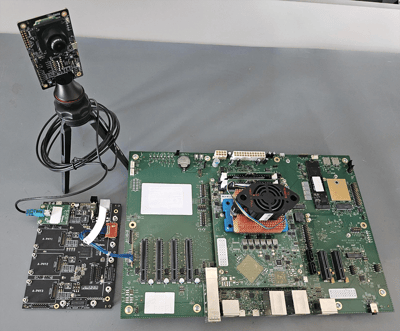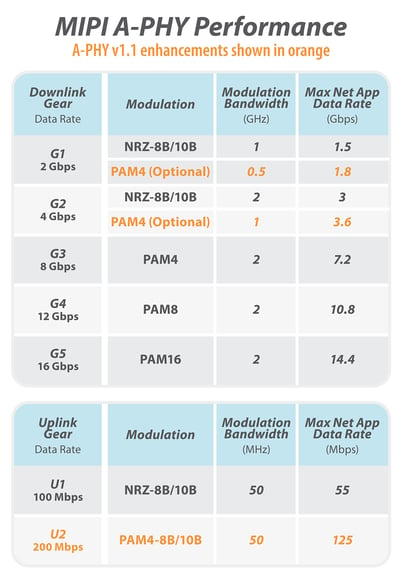3 min read
Intel Implements MIPI A-PHY for Platform Rollout to Automotive Market
![]() Sharmion Kerley, MIPI Director of Marketing and Membership
:
4 April 2024
Sharmion Kerley, MIPI Director of Marketing and Membership
:
4 April 2024

- News & Events
- News
- Blog
Changes in automotive architectures and the rapid climb in the number and complexity of displays and cameras in today's vehicles have amplified the industry’s need for more high-speed data links and networks that deliver greater quality, more robust resilience and enhanced electromagnetic compatibility (EMC) at lower cost.
When Intel sought to develop a platform for the automotive industry, a standards-based solution was key in its requirements, as developing around an established ecosystem would allow for greater efficiencies while opening the door for greater usage of the platform. Using the MIPI A-PHY® SerDes physical layer interface as its foundation, the Intel solution allows the company to leverage the widely implemented MIPI Camera Serial Interface (MIPI CSI-2®), as well as other established interfaces supported by A-PHY Protocol Adaptation Layers (MIPI A-PHY PALs℠).
 The resulting Intel platform integrates MIPI A-PHY v1.1 with the company’s proven processor architectures. A proof of concept was first demonstrated at Intel’s facilities in Karlsruhe, Germany, using an Intel system-on-chip (SoC) for software-defined vehicles in combination with a Valens Semiconductor A-PHY evaluation kit (VA7044 family) and a camera based on a Sony IMX390 sensor. A video stream was transmitted over the A-PHY link to the SoC MIPI RX receiver port. Camera data was successfully handled by the image processing unit (IPU) and displayed on a monitor.
The resulting Intel platform integrates MIPI A-PHY v1.1 with the company’s proven processor architectures. A proof of concept was first demonstrated at Intel’s facilities in Karlsruhe, Germany, using an Intel system-on-chip (SoC) for software-defined vehicles in combination with a Valens Semiconductor A-PHY evaluation kit (VA7044 family) and a camera based on a Sony IMX390 sensor. A video stream was transmitted over the A-PHY link to the SoC MIPI RX receiver port. Camera data was successfully handled by the image processing unit (IPU) and displayed on a monitor.
This was the first presentation of an automotive high-speed connection based on an Intel platform and the A-PHY serializer-deserializer (SerDes) solution.
“MIPI A-PHY is a crucial component of our investment in the automotive market,” Intel’s Frederik John said. “We’re leveraging our own established processor platforms along with an interface from an organization whose specifications have been adopted by the world’s leading chipset vendors to enable developers to consolidate their integration approaches. We see the change in automotive, and we are leveraging known entities to help automakers and suppliers to better meet their evolving requirements.”
More information on Intel’s automotive services can be found here.
About MIPI A-PHY
The MIPI A-PHY SerDes specification is designed for long-reach, high-speed automotive applications, such as advanced driver-assistance systems (ADAS), autonomous driving systems (ADS), in-vehicle infotainment (IVI) and other surround-sensor applications. With the use of the protocol adaptation layers, widely adopted higher-layer protocols, such as CSI-2, MIPI Display Serial Interface (MIPI DSI-2℠) and VESA's DisplayPort and Embedded DisplayPort, can run natively over A-PHY. PALs have also been developed for GPIO, I2C, Ethernet and SPI for command and control channels. A-PHY also supports automotive functional safety requirements of ISO standard 26262, including message counter, CRC-32, keep-alive mechanism and other provisions, to enable the creation of a system-level, end-to-end solution.
Ultimately, with A-PHY, which has also been adopted as IEEE 2977, the need for proprietary bridges is expected to be eliminated in future automotive platform solutions. It also complements Ethernet, CAN, FlexRay and other interfaces in terms of integration with existing network backbones.
When describing the new platform, Intel highlights A-PHY's ability to enable highly power-efficient connectivity using a single coaxial cable of up to 15 meters. Plus, the MIPI specification provides sufficient link bandwidth to support new automotive zonal and centralized compute architectures. This allows designers to optimize systems for the performance, cost and complexity required by their use cases, providing scalability and flexibility to meet a broad range of speed and design needs.
 The A-PHY v1.1 specification doubled the v1.0 specification's maximum downlink data rate from 16 Gbps to 32 Gbps by adding support for dual downlinks over star quad (STQ) cables. This release also doubled the uplink speed from 100 Mbps to 200 Mbps, and expanded PAM4 encoding to lower gears, reducing the operating bandwidth of these gears to allow OEMs, Tier 1s and suppliers to implement A-PHY using lower cost legacy cables and connectors.
The A-PHY v1.1 specification doubled the v1.0 specification's maximum downlink data rate from 16 Gbps to 32 Gbps by adding support for dual downlinks over star quad (STQ) cables. This release also doubled the uplink speed from 100 Mbps to 200 Mbps, and expanded PAM4 encoding to lower gears, reducing the operating bandwidth of these gears to allow OEMs, Tier 1s and suppliers to implement A-PHY using lower cost legacy cables and connectors.
MIPI A-PHY v2.0 is currently completing development and on track to be released later this year. This release is expected to double the interface’s downlink rate to 32 Gbps per lane and boost the uplink rate to 1.6 Gbps.
Prior to the introduction of A-PHY, only proprietary asymmetric long-reach SerDes solutions were available to carmakers. With A-PHY, a broad ecosystem of multiple suppliers is taking shape, which fosters a comprehensive, multi-source environment for automotive OEMs and their suppliers. A reference compliance test suite (CTS) is being finalized, which chip vendors, as well as designers of electronic control units (ECUs), will be able to use to test their products to ensure interoperability with solutions from other vendors. Further, a MIPI A-PHY Compliance Program is being rolled out to provide validation that MIPI A-PHY devices have been tested and deemed compliant with the specification.
To learn more about Intel’s use of A-PHY v1.1 in its automotive platform, attend the 2024 Embedded World Exhibition & Conference, in Nuremberg, Germany, 9-11 April, where Intel experts Frederik John and Dr. Stephanie Friederich will present MIPI A-PHY Camera Ingestion for Automotive x86 Architectures” during the MIPI-focused 5.10 Automotive Design track on 11 April starting at 09:30 CET.
Editor's note: Intel technologies may require enabled hardware, software or service activation. No product or component can be absolutely secure. Your costs and results may vary. Intel does not control or audit third-party data. You should consult other sources to evaluate accuracy. Results have been estimated or simulated.






